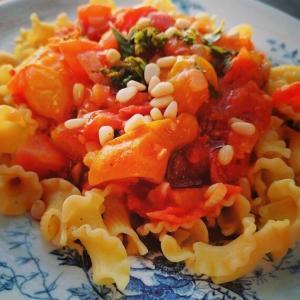I’m not going to tell you my heavenly but easy pasta sauce is rocket science, mostly because it isn’t but also because there’s a ton of recipes out there on the internet that are probably better balanced, more sophisticated and certainly less thrown together than this one, but if you are lucky enough to have access to fresh tomatoes, onions, garlic and fresh basil and are willing to invest in a special quality olive oil there’s not much you can screw up anyway. Also welcome: great parmesan.
Of course you can tweak to taste by adding other veggies or mushrooms, meat if you want and all the herbs that you feel your pasta can’t do without. If you’re not working with homegrown tomatoes, the end result will be accordingly. This is a starting point, not a recipe!
To talk about pasta: sourdough homemade is forever the best way to go, obviously. If you can’t make it yourself (and I get that, it’s an extra, time consuming step): we then usually go for a good quality egg-pasta, because there’s less carbs in that. But all pasta is fine, only if you think it is.
Please don’t overcook the pasta, there’s almost nothing worse than the soft mash of dough you’ll then have no other option than to serve. But again, if you prefer soft, I’m not going to hold that against you. Quantity wise you’re on your own too. Be brave and trust your gut.
You will need:
- As much freshly picked tomatoes you can lay your greedy hands on, cut up in chunks and stems removed, different styles, but preferably some cherry-tomatoes too. Leave cherry-tomatoes whole.Don’t bother taking the skins of.
- Two onions, finally chopped
- Fresh garlic to taste, but four cloves at least, grated
- Olive oil
- A lot of fresh basil, partly chopped, partly left leafy
- Any additional herbs or spices you prefer, fresh or dried,
I often use a finely chopped cajun hot pepper, some rosemary, thyme, lemon balm, marjoram - Pine nuts for taste and decoration
- Good quality parmesan cheese, to grate at the dinner table
Method:
- Heat up a cast iron skillet of decent size or other preferred baking pan with some olive oil
- Add onion and garlic, but be careful not to let it burn, just a quick fry to release taste
- Add half of the tomatoes, leaving the cherry tomatoes for later, fry shortly on high while stirring.
If you want to add other veggies, like zucchini or eggplant, add them now. - Drizzle some more olive oil
- Lower the fire and cover the skillet with a lit
- Let simmer for at least 10 minutes, longer if you prefer a softer sauce with less bite in it.
- Add half of fresh herbs, save leafy ones for plating
- Add dried herbs, salt, pepper and whatever other additions you’ve chosen.
- Add half of the pine nuts so they can suck up the sauce and grow fatter, creamier
- Keep stirring for a while
- Add rest of tomatoes, mostly the cherry ones drizzle some olive oil
- Cover skillet for another simmer of at least 5 minutes
- Use a spoon to push
- Plate the cooked pasta, cover with generous scoops of sauce, fresh basil and rest of pine nuts for a crunch.
- Drizzle some olive oil
- Grate some parmesan over the pasta at the dinner table and don’t wait to dig in, it’s most delicious when hot!
Enjoy!




